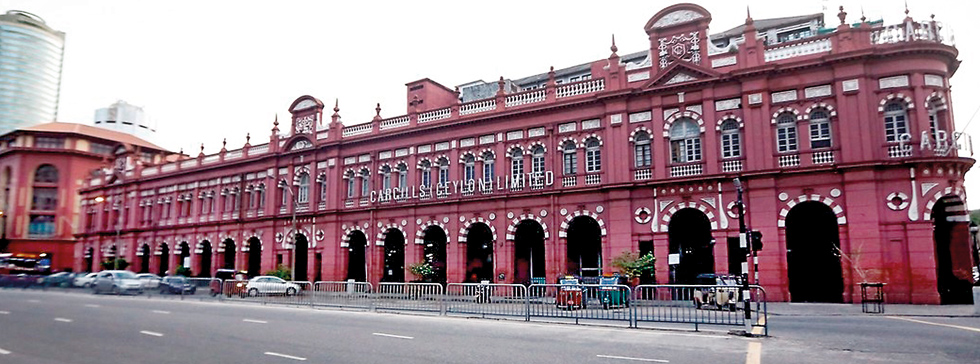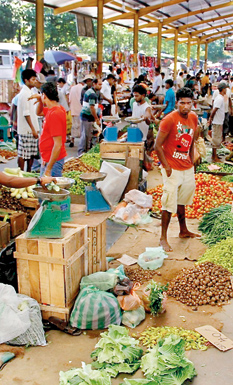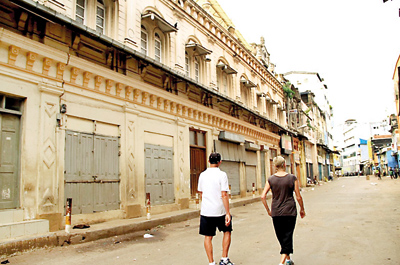Seeing the old city with new eyes
It’s 9 a.m. on a Friday and the Old Dutch Hospital is barely stirring. Standing at the entrance, the World Trade Centre towers at his back, Mark Forbes has his gaze firmly fixed on the past. It’s what he’s become increasingly well known for – this ability to peel back the skin of crowded, bustling Pettah to show you the history, beauty and the culture that hide in plain sight. From the gorgeous buildings to some of the area’s oldest merchants and onto the food, the markets and even the best views, the Colombo City Walk meanders through a part of the city that is in the throes of a profound transformation.

Landmark in Fort: The striking Cargills building
No one appreciates this more than Mark but his perspective takes centuries into account. Talking about how life in the Fort changed under every new occupier, he conjures up images of invasions and counter invasions; of bustling hospitals and the mansions of the elite; of glamorous hotels, staid bankers and haute couture tailoring. In fact, it’s possible that this is the quietest it’s ever been around here. “It’s a dead city today but it’s changing,” he says. “Just wait five years.”
Mark wouldn’t be caught dead with a megaphone – his tours tend to stay small and intimate. He doesn’t do much advertising either – customers come to him through the site www.trekurious.com or through a network of foreign travel agents. Despite the Dutch, German and British blood in his veins, Mark lives here and embraces his Sri Lankan identity- he speaks both Sinhala and Tamil.
His love for the city is a palpable thing, evident in the way everyone – from the security guards posted outside historic buildings to the seller of achcharu out on the street – hails him with the ease of long acquaintance. A professional photographer himself, he will direct his guests to the best vantage point for every building; an amateur historian, he has a fondness for oddities – the nightclub entrance that doubles as a laundry store during the day; the historic, grand ballroom doors that make up one wall of a hotel’s otherwise dingy business centre, the clocks in the tower that waited 40 years to be installed.

History at his fingertips: Mark Forbes
He first began guiding these walks 2 ½ years ago and says his own interest in research grew out of a desire to know about the buildings he was photographing. The route his tours take vary but they often feature the Old Dutch Hospital. Pointing out the 17th century hinges, what used to be the Chief Surgeon’s quarters and the space allocated to an extensive garden, Mark describes how the place must have run with its five surgeons and nursing staff of imported African slaves.
The hospital’s painstaking renovation appears to be catching – spreading outward to the area around, leaping as it were from building to building. In fact the street just beyond is already being done up by Navy renovators who are restoring places like the ‘fertilizer building’ and Australia building using original plans. The insides are gutted but the structure remains original and untouched. “In the future, this is what people are going to come back for,” says Mark, who believes these buildings may yet prove to be the city’s most invaluable tourist resource.
He believes the war years enforced a pause in development and that now the authorities are recognising the value in preserving these old buildings in which history is made tangible. Walking down Chatham Street, Mark tells us this was once a canal that had filled over. The clock tower presides over a street, standing over the spot that marks the city’s zero mileage point. There used to be eight Chinese vendors on this one road but only one survived. Somewhat incongruously named The New Chinese Shop, the business has been in the Chang family for decades and continues to draw clientele in search of readymade school uniforms. At the back of the long, narrow shop are display cases that are over a hundred years old. Win Lee Chang tells us this one of the oldest buildings along the street, dating back 200 years. According to his deeds the space has been used as a residential house, nurse’s quarters and even a goldsmith’s shop.

Crowded and colourful: The bustle of a Pettah market
Waving goodbye to Win Lee, we head back out onto the street and are immediately distracted by a truck selling herbal porridges at Rs.30 a steaming cup. We try the spicy kolakenda and sweet sago with red cadju, while talking to Saman Priya who is up every day at 1 a.m. so he can be in time to meet the breakfast crowd. (Being something of a foodie himself, Mark encourages his guests to sample local treats throughout the walk and has arranged it so that it is built into the fee he charges.)
Weaving in and out through traffic and pedestrians, Mark takes us down York Street. Everywhere renovations are underway. At the original Australian building, workers are scraping off 20 coats of paint to uncover the original red and cream brickwork underneath. In the process they’ve found beautiful old plaques that give us the dates of the original building (1687 and 1900). “None of those were visible a few months ago,” he says. “I keep monitoring this,” he adds, explaining that he’s following the whole process with his camera.
Walking down the shady corridors that were a required element in every design of a Fort building, we find our way to one of Mark’s favourite buildings in the area – Cargills. Completed in 1906, this was once the most glamorous of stores. (Even the salespeople wore suits.) Mark has heard rumours that the building is destined to be taken over by Raffles Singapore and he’s quietly pleased at the thought that all that original brasswork, flooring, lifts, signage, vintage pneumatic pipe system, cashier boxes and other oddities will be restored. The place is certainly worth a visit before that happens, if for no other reason than to appreciate the strange mix of old and new that has cheap Winnie the Pooh stuffed toys piled inside display cabinets that date back to 1906.
Mark knows plenty about the Cargills building, but many other beautiful specimens remain mysterious. “To be honest, it’s so hard finding information. People have written about Cargills but what about these other businesses?” Serendipity has come to Mark’s rescue though and he’s found sources in the most unusual places. One of his favourite stories is about the architects who came down from Singapore with the express purpose of looking at the emblem that adorned the entry to the original HSBC building. It has all the elements you’d expect from the period – the crest complete with the crown jewels, the lion and the unicorn, the Chinese junk but also and right there, the boxes of opium that represent the trade that flourished in those parts. This shady history has led to the emblem being destroyed elsewhere but with this being one of the few that remain it draws experts from all over the world. One hopes that it will be kept intact.
Stepping back out onto the street, we are surrounded by stately, magnificent buildings. Though I’ve passed them on my way to other places before, I find myself looking at them through fresh eyes, drinking in the high, arching ceilings, the delicate tile work, the curling ironwork that encircles tiny balconies. Following our route, we find ourselves at the rear of the President’s House. Mark has ambitions even there – he’s heard reports of a glorious garden inside, complete with iconic statues, that he would like to include as part of his walk. At the Grand Oriental Hotel we stop for lime sodas, slices of chocolate cake and the best view of the harbour to be had.
Beautiful though these buildings are, the beating heart of Pettah lies elsewhere – in the messy, crowded lanes and markets where locals go shopping for all sorts of things. Here you’ll find yourself under a sensory assault: the distinctive scent rolling off the heaps of dried chillies and fish, the glimmer of sequins in imported sarees destined to be worn by local brides, everywhere on the sidewalk, the jostle of humanity intent on shopping. (A word to wise, watch where you’re going, the hand carts on their fat rubber wheels trundle along without care.) In one corner, a space the British built as a concert venue has kept its stage but is now a market where customers can choose from what looks like ten different variations on the coconut scraper and all kinds of practical handicrafts to boot.

On foot: Back to the past in Fort and Pettah
Our final stop for the day is the Old Town Hall. Lying at the intersection of several streets, it is now used as a firehouse complete with shiny red trucks parked outside. Inside, the lovely old building is largely in disrepair, though some rooms are freshly renovated thanks to Bombay Velvet which was filmed here. There’s a makeshift museum on the premises and The council room – complete with a cast of eerie mannequins – is a must see. Several other little pleasures such as windows that glide on ropes and open on to a splendid view of Pettah make this a lovely finish to our tour.
We catch an auto back to the Dutch Hospital while Mark shares his hope that these spaces will be seen for what they are – irreplaceable pieces of history, beautiful and engaging in their own right and worthy of being preserved. Rushing past everything we had lingered over this morning, it’s easy to understand why Pettah is sometimes neglected. Still, any restorations must walk a fine balance between resurrecting the past while respecting the people who live and work in the area – to prioritise one over the other would be a tragedy.
comments powered by Disqus

